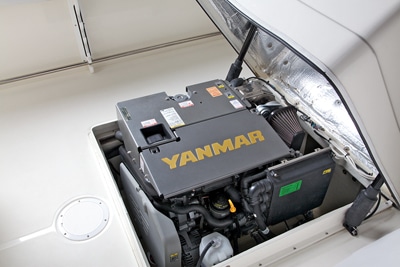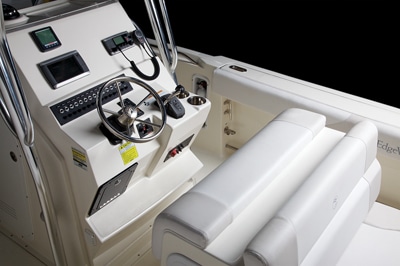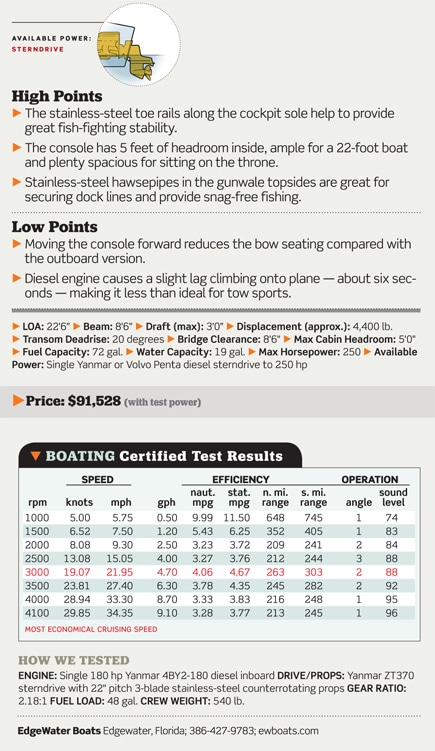A phone call from a fishing lodge looking for a particular kind of boat led EdgeWater Boats down a design path that resulted in turning a 22-foot outboard-powered center console into one with a diesel jack-shafted to a sterndrive. And why do that? For one, there’s a whole megayacht segment looking for rugged center consoles to serve as tenders, and going with diesel means dealing with one fuel source. But also, there’s a growing cadre of compression aficionados who prefer a diesel’s durability and efficiency. Plus, between Volvo Penta, Cummins MerCruiser and Yanmar, there is more choice in smaller lightweight diesels. Like the one you’ll find inside the EdgeWater 228 CCD.
The 228 CCD is powered by a Yanmar 4BY2-180z, which is actually a marinized inline-four BMW engine. It’s compact in size and has a relatively light weight. Paired with Yanmar’s ZT370 sterndrive, the little diesel makes the boat do interesting things. Hitting the throttle, we experienced a slight delay as the diesel’s turbo “wound” up but felt no squat as the boat climbed onto plane.
The boat holds plane at 2,500 rpm and around 15 mph, where it burns a paltry four gallons per hour. Its sweet spot is around 3,500 rpm, where it hits 27.4 mph and burns 6.3 gph, which translates into roughly 4.5 mpg. But the beauty of a diesel is you can run one just a hair off wide-open throttle (WOT) for extended lengths of time without damaging the engine. With three people aboard and 48 gallons of fuel, we topped out at around 35 mph at 4,100 rpm, getting just under 4 mpg. EdgeWater’s own performance data shows that, with the Yamaha F225, the outboard version gets 2.7 mpg at 33.7 mph. (Granted, with the outboard the boat exceeds 46 mph.)

Something important to note: With the Yamaha F225, the 228 CCD sells for $73,329, substantially less than the $91,521 base price of the diesel version. When considering small diesel power, you have to ask yourself if the price increase is justifiable. If you’re a yacht owner and want the tender’s fuel to match the mothership’s, definitely. If you’re a 40-hour a year weekend warrior, maybe not. But the more you use it, the more the efficiency gains will accrue. Besides, there’s more to love about this package than miles per gallon.
While not a speed demon, the 228 truly shone in the handling department. Turning the wheel lock to lock at 30 mph, I executed silky-smooth turns that any runabout owner would love. The sterndrive combined with the dual counterrotating props gives the 228 CCD much more bite in turns than an outboard-powered boat, and we could accelerate through them with no fear of prop blowout. Moreover, the 228’s level running attitude and deep-V hull gave it a solid feel cutting through bay chop or wakes.
The boat’s level attitude stems from moving the engine weight from the transom to amidships, which also altered the boat’s center of gravity (CG.) Despite this, EdgeWater made no changes to the original hull’s running surface. It hired the design firm Marine Concepts to perform hydrostatic tests on the hull, and the company’s engineers said the diesel would actually make it perform better.
Topsides, EdgeWater had to do some rearranging. It moved the center console 10 inches forward and turned the leaning post into the engine compartment cover. No longer needing a motorwell for the outboard, EdgeWater built a narrower transom that adds eight inches of cockpit length. All that newfound space adds up to an exceptionally roomy cockpit, either for fighting fish or for lounging on the optional retracting transom bench. And it did this without losing space for a head in the console.

Another modification involved using a smaller fuel tank — 72 gallons compared with 125 gallons for the outboard version. Even so, the two versions have roughly the same range thanks to the diesel’s efficiency.
EdgeWater is not the only builder with a diesel sterndrive package. Intrepid Boats custom-builds a 245 Diesel, which sells for $195,000 with a D4-300 hp Volvo Penta that reportedly tops 44 mph.
The 228 is built with vacuum infusion using vinylester resin, which allows EdgeWater to use 50 percent less resin than with a conventional layup, making it much lighter in weight. The stringers and hull, as well as the engine bed, are infused at the same time, creating a single unit. The 316L grade stainless-steel hardware is bolted into backing strips. At a glance, the wiring and rigging looked spotless. It’s a good thing it’s so rugged, because with that little diesel you can run the 228 CCD all over the place.
Comparable model: Intrepid 245 Diesel










